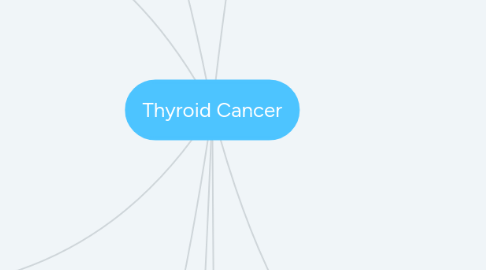
1. Diagnostic Tests
1.1. Blood Test
1.1.1. Thyroid-stimulating hormone TSH
1.1.2. T3 T4 thyroid hormone
1.1.3. Calcitonin
1.1.4. Carcinoembryonic antigen (CEA)
1.2. Biopsy
1.2.1. Results
1.2.1.1. Undetermined
1.2.1.1.1. Can check for BRAF or RET/PTC genes for mutations
1.2.1.2. Suspicious
1.3. Thyroid ultrasound
1.4. Radioactive iodine scan
1.5. Thyroid scan
1.6. Chest X-ray
1.7. Magnetic resonance imaging (MRI)
1.8. Computed tomography (CT)
1.9. Positron emission tomography (PET) scan
1.10. Laryngoscopy
2. Treatments
2.1. Surgery
2.1.1. Lobectomy
2.1.2. Thyroidectomy
2.1.2.1. Hormone replacement with levothyroxine
2.1.3. Isthmusectomy
2.2. Chemotherapy
2.3. Radioactive Iodine Treatment
2.3.1. I-131 to destroy all remaining thyroid tissue and potentially destroy residual cancerous thyroid tissue
2.4. External Beam Radiation Therapy
2.5. Targeted Therapy
3. Risk and Causative Factors
3.1. Diet low in iodine
3.1.1. In United States iodine is added to table salt
3.2. Radiation Exposure
3.2.1. Medical treatments
3.2.2. Nuclear fallout
3.2.2.1. Chernobyl
3.2.2.2. Mesquite, NV and St George, UT from above ground testing at NV test site
3.3. Imaging Tests in children increase risks
3.3.1. CT scans
3.3.2. X-rays
4. Signs and Symptoms
4.1. Lump in neck
4.2. Hoarseness voice that won't go away
4.3. Swelling in neck
4.4. Pain in front of neck that extends up to ears
4.5. Trouble swallowing
4.6. Trouble breathing
5. Cancer Stageing
5.1. T- is tumor size
5.2. N- nearby lymph nodes
5.3. M-metastasis to other sites
5.4. Numbers or letters after T, N, and M provide more details about each of these factors
5.5. All anaplastic thyroid cancers are considered stage IV, reflecting the poor prognosis for people with this type of cancer.
6. Statistics
6.1. About 53,990 new cases each year
6.2. About 2,060 deaths each year
6.3. 3 out of 4 cases are found in women
6.4. Most rapid rising cancer in the United States, tripling in lat 30 years
6.4.1. Advances in testing account for rise of diagnosis
7. Types of thyroid cancer
7.1. Differentiated
7.1.1. Papillary
7.1.1.1. 8 out of 10 thyroid cancers are papillary cancers
7.1.1.2. Cancers tend to grow very slowly and usually develop in only one lobe of the thyroid gland
7.1.1.3. Can spread to lymph nodes in neck
7.1.1.4. Can be successfully treated, rarely fatal
7.1.2. Folliculary
7.1.2.1. Second most common type of thyroid cancer accounts for 1 in 10 cancers
7.1.2.2. More common in countries without iodine in diet
7.1.2.3. Usually does not spread to lymph nodes
7.1.2.3.1. Can spread to other parts of the body like bones and lungs
7.1.2.4. Prognosis good but not as good as papillary cancer
7.1.3. Hṻrthle cell
7.1.3.1. About 3% of thyroid cancer
7.1.3.2. Harder to find and treat
7.2. Medullary (MTC)
7.2.1. About 4% of thyroid cancer
7.2.1.1. Two types
7.2.1.1.1. Sporadic MTC
7.2.1.1.2. Familial Medullary Thyroid Caner (FMTC)
7.2.2. Develops from C cells of the thyroid gland that makes calcitonin
7.2.3. Can spread to lymph nodes lungs, or liver before discovery
7.3. Annaplastic
7.3.1. Rare form of thyroid cancer
7.3.2. Very hard to treat
7.3.3. Less than 2% of thyroid cancer
8. Pathophysiologic Etiology
8.1. Often estrogen receptor positive, which may explain female predominance of tumors in reproductive years (for other ages, incidence in males and females is similar
8.2. More common in United States whites than blacks, for unknown reasons
8.3. Increased risk for children exposed to ionizing radiation, particularly under age 1 year, women atomic bomb survivors in Japan
8.4. Medullary thyroid cancer (MTC) develops from the C cells in the thyroid
8.5. Having a first-degree relative (parent, brother, sister, or child) with thyroid cancer, even without a known inherited syndrome in the family, increases your risk of thyroid cancer
8.6. Familial Medullary Thyroid Caner (FMTC)and tumors of other endocrine glands is called multiple endocrine neoplasia type 2 (MEN 2)
8.6.1. Two sub types
8.6.1.1. MEN 2a, occurs along with pheochromocytomas (tumors that make adrenaline) and with parathyroid gland tumors
8.6.1.2. MEN 2b, MTC is associated with pheochromocytomas and with benign growths of nerve tissue on the tongue and elsewhere called neuromas
8.6.1.2.1. Less common but more aggressive
8.6.2. Inherited Forms
8.7. Inflammation
8.7.1. Thyroid gland is more susceptible to the oncogenic effects of chronic inflammation
8.7.2. Chronic inflammation promote continued proliferation, inflammatory cells release compounds that can promote mutations and block the cellular response to DNA damage

